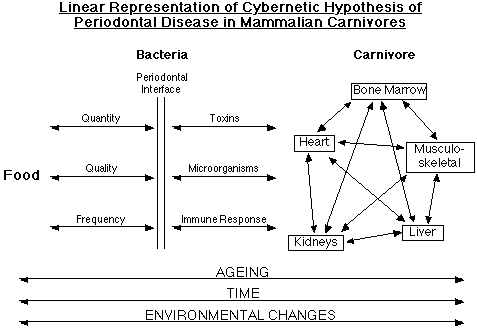
| First published in: | Journal
of Veterinary Dentistry March 1994 Vol. 11 No. 1 Pages 5-8 |
| Summary | The Hypothesis | References |
| Introduction | What Next |
Lovelock, J.E., 1979.Lesser discoveries frequently depend on the failure of a system. Mistakes and failings lead us to reappraisal and a deeper understanding. In veterinary medicine the prime mistake of the late twentieth century is brought to us through the widespread feeding of artificial foodstuffs. It is by virtue of the diabolical affront to natural systems that the Cybernetic Hypothesis of Periodontal Disease derives.
Mee A.Other universally accepted truths are:

a. Nine contented, well-fed wolves.The unequal struggle begins as his 'appointed part in keeping down numbers' is made redundant. The pathogens benefit. Their numbers sharply increase by day fourteen. The sheep gain since only nine wolves now give chase.
b. His own twenty-four hour starvation
c. Increased plaque accumulation.
a. In a short time, and with minor challenge, the immune system will provide a minor degree of protection sufficient to protect the host genes and therefore the gene pool.It is important to note that this graduated response facilitates the shaping of populations. ie the animal which employs the immune system least will be the best adapted to its environmental niche and therefore have the greatest breeding potential.
b. As either the time frame or the degree of challenge increases the immune system will provide a major response. This major response will serve to expedite the demise of the host genes. The concomittant of this being that the host gene pool (a critical issue) will be protected.